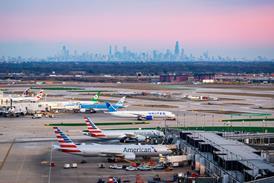Cutting labour costs has emerged as a key industry issue, with asset productivity not too far behind. Chris Tarry of CTAIRA looks at what the performance measures reveal about the US industry's progress.
The latest reporting season has brought with it a mixed bag of financial results from the major carriers, but there is at least one common theme: labour. Whether it is the British Airways management warning of the coming "headwinds" or more forthright language from the Delta boardroom, labour costs loom large. Indeed, open hostility to further cost-cutting at US Airways has prompted the resignation of chief executive David Siegel.
Naturally, no business can sustain, let alone grow, profits simply by cost cutting. A number of cost issues still remain. Of those, the productivity of labour and assets both stand out. But that, in turn, poses the question of how managements set about measuring productivity performance. There is, of course, a whole armoury of measures, but, as we have argued before, a certain fixation still remains on the classic yardstick of available tonne kilometres per employee.
It is true that this is a simple measure, but it can also be misleading. It is quite possible for unit tonnes per employee to be rising as a result of larger aircraft flying longer distances, rather than any basic reduction in labour numbers or smarter working practices. Better to measure revenue productivity. While it would be wrong to suggest that this measure is perfect, it does, in effect, show what a dollar of labour cost, or indeed asset spend, "produces" in terms of revenue.
Although labour is arguably the most pressing issue, it is important not to neglect assets given the impact of structural market shifts in the medium term. There have already been increasingly vocal warnings that aircraft are too cheap, suggesting that book values may yet have to be written down further. On the other hand, there are equal concerns that lease rates will have to rise to reflect more appropriate depreciation schedules, let alone any cyclical recovery that might occur.
More importantly, the value generated by each unit of asset cost (depreciation plus aircraft rentals) has fallen significantly over the last two years. Despite the stated reductions in capacity there is still a high fixed cost that the industry has had to bear.
The point is highlighted by a look at the latest performance of the US industry, for which full 2003 figures are already available. Taking a reference group of six majors - American, Delta, Continental, Northwest, Southwest and United - it is apparent that the asset productivity ratio has declined from 10 to eight times as a proportion of revenues.
Looking at this from one end of the telescope, all other things being equal, the cost of assets needs to be reduced. However, given the current concerns that depreciation rates may already be too long, the risk is that the cost of assets shown in the profit and loss account may rise and the ratio deteriorate further. We shall watch with interest.
As regards labour, the productivity multiplier, the ratio of dollars earned to costs spent has slipped from a factor of three at the end of 2000 to a low point of 2.25 in 2002. In other words, these carriers earned $3 of revenue for every dollar spent on labour in 2000, but only $2.25 two years later. That was predictable enough. It is also encouraging that the ratio has subsequently recovered to 2.43, thanks to stable revenues and a decline from peak labour costs in 2002 - these fell by 7% last year.
But, in order to return to the multiplier of 2000, either revenue needs to increase by 25% or labour costs fall by 20%. The reality is that while there will be some revenue growth, labour costs remain too high and there is a real risk that they could go actually go higher.
Despite theories to the contrary, labour is, in fact, a fixed cost. The opportunity here is to grow revenue against a fixed cost base to produce good marginal profitability - but again this is likely to be a relative rather than absolute gain.
To take another perspective, the cost of production in the industry remains too high for the likely revenue stream and there needs to be a step change re-adjustment in the economics. Despite this, some governments seem intent on attempting to sustain the unsustainable, which will only enshrine inefficiency and distort competition.
Source: Airline Business























